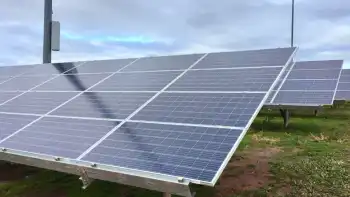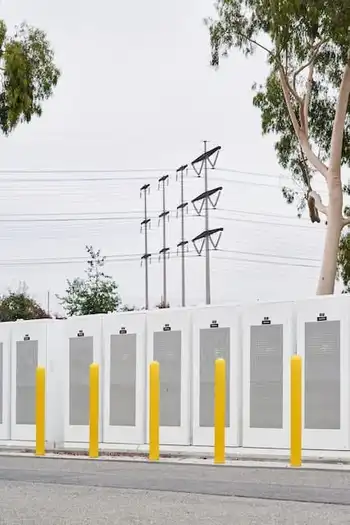Will County plan latest victim of critics of pollution
By McClatchy Tribune News
Arc Flash Training CSA Z462 - Electrical Safety Essentials
Our customized live online or in‑person group training can be delivered to your staff at your location.

- Live Online
- 6 hours Instructor-led
- Group Training Available
But growing concerns about global warming, lingering problems with noxious air pollution and skyrocketing construction costs are slowing the nation's coal rush to a crawl.
Indeck Energy Services Inc. has told state regulators it has abandoned plans for a large power plant on the former Joliet Arsenal site. The proposed plant had been seen as a showcase for the state's vast coal reserves. The Indeck project is the latest coal plant to be defeated, canceled or placed indefinitely on hold during the last year.
By various accounts, more than 60 new plants have been scuttled across the nation, an abrupt shift from the 150 in the works only a year ago.
Some projects are still moving forward. For instance, Illinois is on track for the largest coal plant - and biggest source of heat-trapping carbon dioxide - built in the U.S. since the early 1980s. Yet major Wall Street investment banks recently signaled hey will consider the cost of controlling greenhouse gases before financing new power plants, adding another potential deal breaker to legal challenges from environmental groups.
"The thing about coal right now is it has a very bad image," said Gerry DeNotto, president of Buffalo Grove-based Indeck, which gambled five years ago that a new coal plant in Will County would be less expensive than the natural gas plants it had been building elsewhere.
Most analysts think coal will remain a large part of the energy mix, at least for the near future. Power plants that burn the black, carbon-rich fuel now provide about half of the electricity generated nationwide. But those plants also are the largest source of carbon dioxide and mercury emissions and are major sources of air pollution that creates lung-damaging soot and smog.
With many aging coal plants operating well beyond their expected life spans - the oldest in Illinois was built in 1947 - there has been a fierce battle in recent years about how the U.S. should meet a projected surge in demand for electricity.
Companies like Exelon want to build more nuclear plants, environmental groups and energy entrepreneurs are pushing for more wind and solar power, and others think natural gas is the answer, depending on the price.
Until recently, coal was seen as the least expensive alternative. No state had more coal-fired power plants on the drawing board than Illinois, where at one point state officials were touting 10 projects that would burn coal mined in southern Illinois. Just three remain active.
Environmental groups, led by the Sierra Club, have challenged most of the proposed plants on the grounds that they would emit too much pollution linked to asthma and other respiratory ills.
"It was important to raise the alarm early with projects like Indeck," said Bruce Nilles, an attorney who leads the Sierra Club's national coal campaign. "Most of these proposed coal plants don't make sense when you take a closer look."
Many forecasters have dramatically scaled back their projections for future electricity demand. More than ever, though, global warming is making political leaders, state environmental regulators and investment banks wary of new coal projects. Last month, Kansas Gov. Kathleen Sebelius, a Democrat, vetoed legislation intended to overturn her administration's decision to deny permits for two new coal plants.
Her top environmental regulator said the state couldn't ignore the dangers posed by climate change. Citing similar drawbacks, Republican Gov. Charlie Crist of Florida pressured utilities to drop plans for two coal plants in his state.
The most dramatic turn came last year when TXU Corp., a Texas energy giant that had long been the bane of environmental groups, shelved 8 of 11 planned coal plants. The company now is making major investments in wind energy.
"Developers are increasingly concerned about being penalized for carbon emissions," said Steve Piper, who tracks power forecasts for Platts, an industry trade journal. "It's giving many people pause."
Most climate scientists agree that human activities - mainly the burning of coal, oil and other fossil fuels - are driving up global temperatures. Many believe that if action is not taken soon to reduce greenhouse gases, the result could be widespread weather shifts, coastal flooding, prolonged droughts and deadly heat waves.
Congress is debating bipartisan legislation that for the first time would regulate carbon dioxide and other greenhouse gases linked to global warming. The major presidential candidates, Sens. Barack Obama (D-Ill.) and John McCain (R-Ariz.), have vowed to make climate change a key part of their agendas once in office.
Both candidates back a system that would cap greenhouse gas emissions and let companies trade the right to pollute. Cleaner companies would be able to sell credits, or pollution allowances, to dirtier firms as long as they all stayed below the national limit.
Because coal is the most carbon-intensive way to generate electricity, it could end up becoming more expensive than nuclear power or natural gas, according to a recent study by the Electric Power Research Institute, an industry trade group. Even without a price on carbon, ballooning construction costs led the U.S. Department of Energy in January to quash a $1.8 billion power plant near Downstate Mattoon that had been billed as a model for keeping coal viable.
The plant would have captured carbon dioxide emissions and injected the gases deep underground, a process known as carbon sequestration. One of the remaining coal plants still in the works for Illinois would be designed to more easily use the same technology.
But Tenaska Inc., the Omaha-based company seeking to build the new facility near Downstate Taylorville, so far has ruled out installing it.
"We're facing some new challenges, but that's why we need to press on with clean-coal technology," said Phil Gonet, president of the Illinois Coal Association. "Keep in mind we've got a lot of coal, it's low-cost right now and it's a proven way to meet our energy needs."
Several coal plants across the country are moving forward despite the financial and regulatory uncertainty.
The biggest is a 1,600-megawatt power plant in Downstate Washington County being built by the nation's largest coal company, St. Louis-based Peabody Energy. The giant coal burner is expected to provide electricity to 2.5 million people in nine states. It also would be the largest source of carbon dioxide built in the U.S. in more than two decades, churning out 12 million tons of the gas each year.
Cleaner sources of electricity are under construction as well. During the five years since Peabody and Indeck proposed building new coal plants in Illinois, the state has added more than 700 megawatts of pollution-free wind energy.
Nationwide, more than 5,000 megawatts of wind power were added last year, and a recent Energy Department report estimated that wind turbines could provide 20 percent of the nation's electricity by 2030. Wind energy now accounts for about 1 percent of the nation's total electricity.
"The landscape is changing quickly," said Ron Burke, who heads the Chicago office for the Union of Concerned Scientists. "Even the big companies that have relied on coal are starting to invest in wind and other renewable energy. They see the writing on he wall too."











